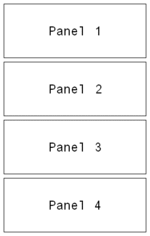
| Part of a series on |
| Anime and manga |
|---|
 |
|
|
Yonkoma manga (4コマ漫画, "four cell manga" or 4-koma for short) is a comic strip format that generally consists of gag comic strips within four panels of equal size ordered from top to bottom. They also sometimes run right-to-left horizontally or use a hybrid 2×2 style, depending on the layout requirements of the publication in which they appear. Although the word yonkoma comes from Japanese, the style also exists outside Japan in other Asian countries as well as in the English-speaking market, particularly in mid-20th century United States strips, where Peanuts popularized the format.[1]
YouTube Encyclopedic
-
1/3Views:13 1325 8083 715
-
Yonkoma Manga Theater - A Night in Saturn Valley
-
Yonkoma Manga Theater - Jeff and Tony (no subtitles)
-
Crea il tuo PRIMO MANGA - Yonkoma
Transcription
Origin
Rakuten Kitazawa (who wrote under the name Yasuji Kitazawa) produced the first yonkoma in 1902. Entitled Jiji Manga, it was thought to have been influenced by the works of Frank Arthur Nankivell and of Frederick Burr Opper.[2]
Structure
Traditionally, yonkoma follow a structure known as kishōtenketsu. This word is a compound formed from the following Japanese kanji characters:
- Ki (起): The first panel forms the basis of the story; it sets the scene.
- Shō (承): The second panel develops upon the foundation of the story laid down in the first panel.
- Ten (転): The third panel is the climax, in which an unforeseen development occurs.
- Ketsu (結): The fourth panel is the conclusion, in which the effects of the third panel are seen.[2]
Uses
These comic strips appear in almost all types of publications in Japan, including manga magazines, graphic novels, the comics section of newspapers, game magazines, cooking magazines, and so forth. The plot often ends within the four panels; although some serial development may pass on to future installments, creating a more continuous story. Some yonkoma also tackle serious topics, though most do so with humor. Some manga occasionally use yonkoma, usually at the end of a chapter or bound volume, as a non-canon joke to complement the story.
See also
- Jo-ha-kyū – A type of three-act structure found in many traditional Japanese narrative forms
References
- ^ Walker, Brian (2002). The comics: since 1945. New York: Harry N. Abrams, Inc.
- ^ a b Fischer, Carolin. "Yonkoma Manga". Mangaka.co.uk. Archived from the original on 2010-07-20. Retrieved 2009-10-29.
